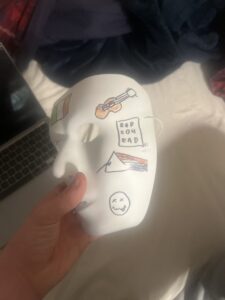


Category: Uncategorized
STEAM Mask – Suzanna Grigoryan


STEAM Mask – Shahad

STEAM Mask – Elisa Ujkashi

Scenes of a Latin Quarter, Rent and the Opera Lecture – Elisa Ujkashi
I found some parallels between the reading Scenes of the Latin Quarter from last week and the musical Rent. However, given that it deals with such profound subjects, I believe I would have liked this more as a film than a musical. I saw right away that the character’s hardships and environment in both the text and the musical exalt the image of the starving artist. The apartment in which Roger and Mark reside is exactly how I would picture it from the readings. Very dilapidated, with very little furnishings and only the essentials to survive. That, along with Mark’s film equipment and Roger’s instrument. Some of the primary characters are having financial difficulties and some struggle with their health because they have AIDS and HIV. I didn’t see any mention of HIV or AIDS in the reading, so this reminded me of Patti Smith’s Just Kids, which also touches on these subjects and Robert’s premature death from the illness. One sequence in particular from the film quickly drew my attention because it was nearly the exact same as the reading’s scene between Rodolphe and Mimi. However, the male character in the musical is called Roger. The scene with the candle symbolizes the beginning of Roger and Mimi’s potential romance. Personally, I believe that the candle’s flame represents the fluctuating nature of life’s unpredictable prospects. Although it was known that people weren’t very accepting of publicly homosexual individuals in the 1970s, I enjoy that the musical depicts support groups and coping strategies for those with HIV and AIDS, including those who were out gay. The sequences in which Angel dies of AIDS and Mimi battles both AIDS and a drug addiction were particularly painful to watch because it is obvious that both characters are going through challenging times in their lives, or in Angel’s case, the end of his life. It was very difficult for me to witness his friends’ anguish because grieving is one of those things that affects everyone deeply. The musical does an excellent job of captivating the grief and raw emotions displayed by the characters, allowing the audience to feel for them. The musical depicts love, joy, hope, hardship, loss, and heartbreak all which stick out in one’s mind. Overall the musical left an impact on me and did make me a bit emotional. I found myself being able to connect this musical to not only Scenes of the Latin Quarter but Just Kids as well.
Mask

STEAM Mask by Brendan Kwan



Scenes of a Latin Quarter, Rent, and Opera
I believe that the musical Rent and the reading Scenes of the Latin quarter both display an artist who embraces his own struggles and surroundings. The apartment that was shown was very basic and run down, housing only the necessities to live. Alongside Mark and Roger’s apartment, the other character’s are in the same boat as them; this being poor finances and health concerns. The HIV and AIDS crisis were touched upon here, but it did not seem to be as prominent in the physical reading. During this time, being openly gay was often looked down upon.
Alongside this, Maureen’s performance seemed rather confusing. The part were she had the crowd moo when she talked about milk did not really make sense. With the reading, I personally found the different plots hard to follow and understand. Despite this, I think that the chapter Mademoiselle Mimi was easier to understand and follow. I found it more enjoyable to read and the emotion throughout the chapter was clear to see.
The Opera was even harder to understand for me. I do believe it is a unique way of presenting something, but I found it difficult to appreciate its uniqueness. However, I think the musical did a very good job showing the emotions of grief and despair, which allowed the audience to connect more deeply with the characters. Overall, I think the musical was the best of the three, because of the way it engaged the audience.
STEAM mask
STEAM Mask




